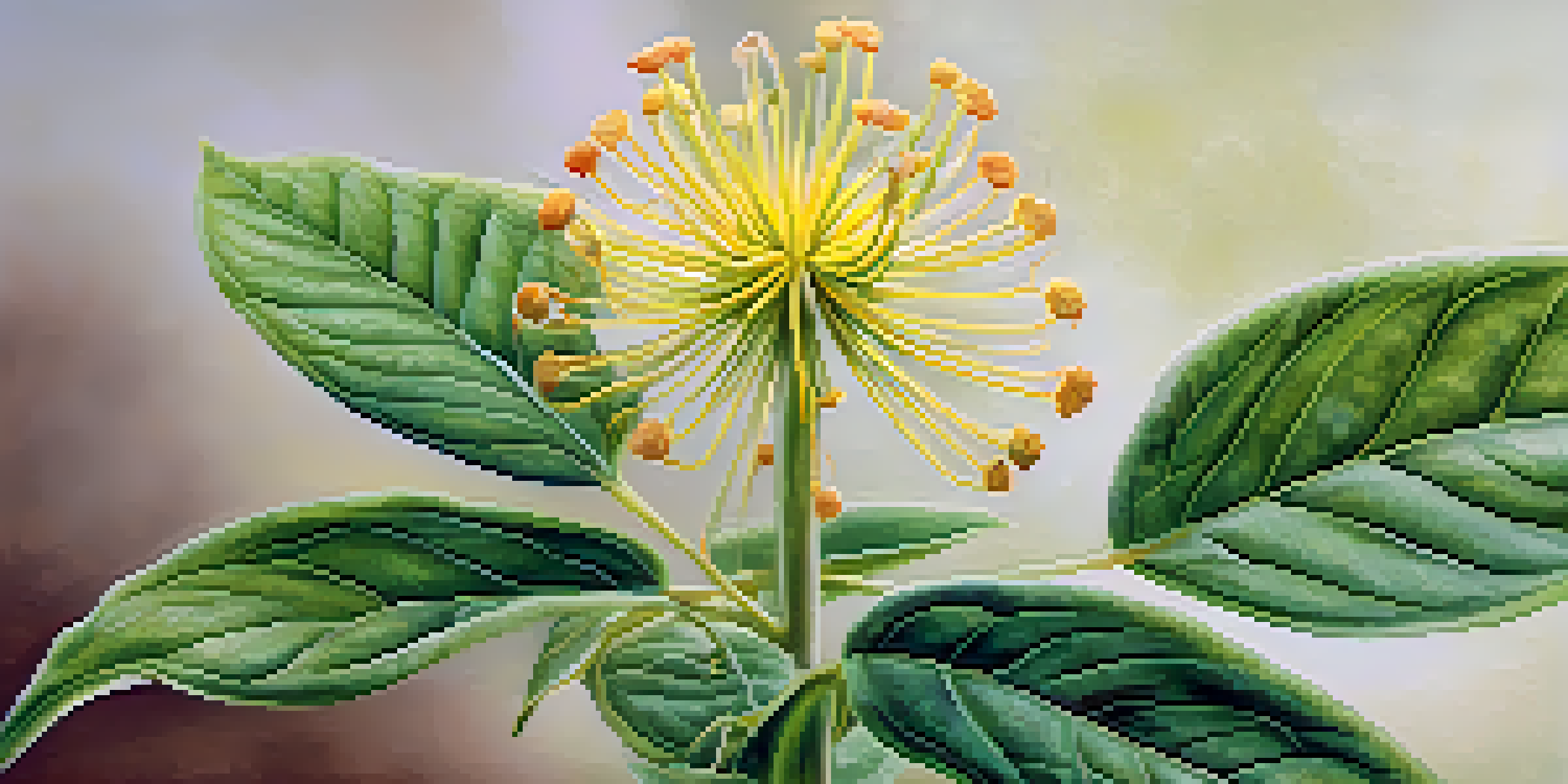The Importance of Biodiversity in Medicinal Plant Use

Understanding Biodiversity and Its Importance
Biodiversity refers to the variety of life forms on Earth, including plants, animals, and microorganisms. This diversity is essential for ecosystem health and stability, as it ensures that various species can perform their roles effectively. For instance, a diverse range of plant species can lead to a more resilient ecosystem, capable of withstanding environmental changes.
Biodiversity is the foundation for a sustainable society.
In the context of medicinal plants, biodiversity plays a crucial role in providing a rich source of compounds that have therapeutic effects. Each plant species possesses unique chemical properties that can lead to the development of life-saving medicines. The more diverse the plant life, the greater the potential for discovering new medicinal compounds.
Moreover, biodiversity contributes to the sustainability of medicinal plant use. By maintaining a wide variety of species, we reduce the risk of over-reliance on a single plant, which can lead to depletion and loss of valuable resources. This variety is vital for future generations, ensuring they also have access to effective natural remedies.
Cultural Significance of Medicinal Plants
Medicinal plants have been an integral part of many cultures around the world for centuries. From traditional Chinese medicine to Ayurvedic practices in India, these plants are often revered not just for their healing properties but also for their cultural significance. This deep-rooted connection emphasizes the importance of preserving biodiversity.

When communities use medicinal plants, they often develop unique knowledge systems that are passed down through generations. This traditional knowledge is invaluable, as it can guide the sustainable use of these plants while promoting conservation efforts. For example, indigenous groups often have specific practices for harvesting that ensure plant species remain abundant.
Biodiversity Supports Ecosystem Health
A diverse range of species is essential for maintaining the health and stability of ecosystems, which directly impacts the availability of medicinal plants.
Furthermore, the loss of biodiversity can lead to the erosion of these cultural practices. As certain plants become extinct or endangered, the traditional knowledge associated with them may also fade away. Preserving biodiversity is thus not only about conserving plants but also about safeguarding cultural heritage.
The Role of Ecosystems in Medicinal Plant Production
Healthy ecosystems provide the ideal conditions for medicinal plants to thrive. Factors such as soil quality, climate, and interactions with other species all influence plant growth and medicinal properties. For instance, certain medicinal plants may require specific soil types or companion species to flourish, highlighting the interconnectedness of biodiversity.
The future will be determined by the legacy we leave behind for our children and for the natural world.
Ecosystems rich in biodiversity can also enhance the resilience of medicinal plants against pests and diseases. When a variety of species co-exist, they often create a natural balance that helps to keep harmful organisms in check. This ecological balance is essential for the sustainable harvesting of medicinal plants, ensuring they remain available over time.
Additionally, diverse ecosystems contribute to the overall health of the environment, which indirectly supports medicinal plant production. For example, pollinators such as bees and butterflies play a critical role in plant reproduction. Protecting these vital species ensures the continued existence of the plants that are crucial for medicinal purposes.
Threats to Biodiversity and Medicinal Plants
Despite the invaluable role of biodiversity in medicinal plant use, it faces numerous threats. Habitat destruction due to urbanization, agriculture, and deforestation significantly reduces plant populations. As natural habitats shrink, the variety of available medicinal plants diminishes, limiting our ability to discover new treatments.
Climate change is another pressing threat that affects biodiversity. Changing temperatures and weather patterns can alter plant growth cycles and distribution, pushing some species toward extinction. This not only threatens the plants themselves but also the ecosystems that depend on them, creating a cascade of negative effects.
Cultural Heritage Tied to Medicinal Use
The traditional knowledge surrounding medicinal plants is deeply rooted in various cultures, making biodiversity preservation crucial for maintaining cultural practices.
In addition, overharvesting of medicinal plants for commercial use can lead to population declines. Unsustainable practices can wipe out entire species before we fully understand their potential benefits. Therefore, it's critical to implement conservation strategies to protect these plants and their habitats.
Conservation Efforts for Medicinal Plants
To combat the threats facing biodiversity, various conservation efforts are underway globally. These initiatives focus on protecting habitats, restoring ecosystems, and promoting sustainable harvesting practices. For instance, botanical gardens and seed banks play a vital role in preserving medicinal plant species and their genetic diversity.
Community-based conservation programs also empower local populations to protect medicinal plants. By involving indigenous communities in conservation efforts, we can leverage their traditional knowledge and practices to create effective strategies. This not only helps protect biodiversity but also strengthens local economies.
Moreover, raising awareness about the importance of biodiversity can inspire collective action. Educational campaigns and partnerships between governments, NGOs, and local communities can drive efforts to safeguard medicinal plants. By understanding their value, we are more likely to support initiatives that protect them.
The Future of Medicinal Plant Use
Looking ahead, the future of medicinal plant use relies heavily on the preservation of biodiversity. As science progresses, there is a growing recognition of the potential benefits hidden within various plant species. The ongoing search for new medicines underscores the need to maintain a rich variety of plants.
Innovative approaches, such as bioprospecting, are emerging as effective strategies to explore and utilize medicinal plants sustainably. This involves searching for valuable compounds in diverse ecosystems while ensuring that local communities benefit from the discoveries. This mutually beneficial relationship can promote both conservation and economic growth.
Conservation Efforts Are Essential
Implementing conservation strategies is vital to protect medicinal plants from threats such as habitat destruction and climate change.
Ultimately, the future hinges on our commitment to protecting biodiversity. By prioritizing conservation efforts, we can ensure that medicinal plants remain available not just for today but for generations to come.
How Individuals Can Contribute to Biodiversity
Every individual has a role to play in supporting biodiversity and, by extension, the use of medicinal plants. Simple actions, such as planting native species in gardens, can help create local habitats that support various flora and fauna. Engaging in community clean-up efforts can also protect natural habitats.
Supporting sustainable brands that prioritize the use of ethically sourced medicinal plants is another impactful way to contribute. By choosing products that are certified organic or sustainably harvested, consumers can help reduce the pressure on vulnerable species and ecosystems. Every purchase sends a message about the importance of conservation.

Additionally, educating oneself and others about the benefits of biodiversity can create a ripple effect. Sharing knowledge about the significance of medicinal plants can inspire others to take action, fostering a culture of conservation and respect for nature.